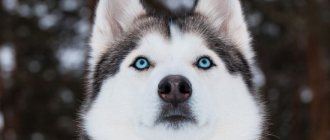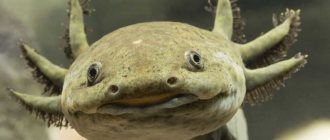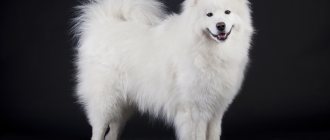The official description of the Shar Pei breed standard notes their intelligence, nobility, arrogance, and restraint. But at the same time, these majestic representatives of guard and hunting dogs that came to us from China are extremely loyal. They are excellent companions and guards.
Shar-Peis are attracted by their unusual appearance: short-haired coat and accordion-like skin, which completely covers the body of puppies, and in adults only the neck and muzzle, and the blue-black color of the tongue.
Shar Pei has a difficult temperament. In addition, it is sensitive to a person’s uncertainty and fear. But if he declares his leadership, shows himself as a caring and loving owner, then boundless devotion on the part of the pet is guaranteed to him.
Important! For those who want to adopt a dog of this unique breed, it is important to first learn about its habits, rules of keeping, character, and feeding. After all, only complete knowledge about this difficult pet will help ensure its reliable health, development, and achieve complete mutual understanding and contact with it.
Brief characteristics of the breed
Shar Peis make excellent protectors and friendly companions.
Shar Peis are special pets. The description of their physique, which meets the Chinese standard, is extraordinary: the ears are shaped like a shell, the nose is like a butterfly, the head is like a melon, the neck is like a hippopotamus, the back is like a horse, and the paws are like a dragon. In addition, modern representatives of the breed have a blue tongue and a rooster's tail, which makes them similar to other dogs - the Chow Chow.
The back and head of dogs are covered with characteristic wrinkles. In puppies, they appear too large in comparison with their small bodies. Adult animals still have a few wrinkles in their fur.
Sizes of the breed:
- males - up to 51 cm at the withers;
- girls are smaller, up to 48 cm.
The weight of dogs, depending on their size, varies from 18 to 25 kg.
Other characteristics of Shar Peis:
| Characteristics | Description |
| Head shape and size | Large compared to body proportions. Flat and wide skull shape. There are wrinkles on the forehead and cheeks that gather in the shape of a drop. |
| Ear shape | Resembles small triangles, with pointed ends. |
| Eye shape and color | Almond-shaped, dark iris color. The expression of the eyes is gloomy. |
| Body lines | The upper one is slightly lowered to the bottom, the lower one is directed upwards. The chest is wide. |
| Tail | At the base it is thick, tapering towards the tip. It has a curved, tightly twisted shape. Set high. |
| Wool qualities | Very short and straight, tough. There is no undercoat. |
| Color | Solid color, from grayish to black, from cream to red-brown. May be lighter on back of thighs and tail. Can be anything except white. |
Important! The Shar Pei is not a hypoallergenic dog. Despite their short hair, they lose it in no less quantities than representatives of other breeds.
Animals shed 2-3 times per year
Diseases
Shar Peis do not get sick more often than other dogs, but they have a predisposition to certain diseases. The following organs and systems may suffer from diseases:
- respiratory system (brachycephalic syndrome, pneumonia, atrial fibrillation);
- skin (allergic dermatitis, demodicosis, sarcoptic mange, pyoderma, hypothyroidism, mastocyoma, etc.);
- eyes (entropion, glaucoma, retinal dysplasia, chemosis);
- ears (malasseziasis, hyperplastic otitis, stenosis of the auditory canal);
- musculoskeletal system (osteodystrophy, hip dysplasia, osteochondrosis);
- digestive system (megaesophagus, immune-related inflammation, adenocarcinoma, ulcers);
- endocrine system (Cushing's disease, Addison's disease);
- kidneys and urinary system (renal amyloidosis).
Content Features
In the past, the breed was considered a service breed and was used for herding and guarding livestock, hunting, and also as a professional fighter. Nowadays Shar-Peis are more often adopted as companion dogs.
Note! The breed is distinguished by the fact that the animals are odorless and compact in size; they can live in a private household or a modest-sized apartment. At the same time, most breeders, when answering the question whether Shar Pei can live on the street, answer negatively.
Caring for a Shar Pei at home should take into account the following needs of pets:
- The food bowl should always be kept clean. An oilcloth should be placed under it, since most representatives of the breed scatter pieces of food while eating due to the structural features of the muzzle.
- The bed should not be in a draft or in the aisle. At the same time, the place must be chosen so that the dog has a good view.
- The preferred materials for the bed are natural, hypoallergenic. The litter should not be hard, but not overly soft.
- Shar Peis generally do not experience discomfort when traveling in a car.
- The breed does not tolerate frost and heat well, as it lacks undercoat. This explains the negative answer to the question whether a Shar Pei can be kept outside. The only possible option for outdoor housing is in a well-heated enclosure with a booth.
The right approach to knitting
Mating is a very responsible process, and first of all for the owner. How to approach this issue correctly? It is important for the owner of a male dog to consider the possibility of subsequent matings.
To do this, the dog must have a good pedigree, participate in exhibitions and have a good appearance. Otherwise, there are unlikely to be many people who want to get puppies from such a dog.
If this is the case, it is better not to breed the dog at all, otherwise he will run after all the females. It is better not to breed him, and over time his sexual instinct will fade away, and the male will not feel a craving for females.
For owners of bitches, the situation is more serious, since as a result of a successful mating, cheeks will appear that will need to be fed, provided with vaccinations, and then future owners be found for them. This is a complex and expensive process. When breeding a bitch, you need to consider the following factors:
- the dog's popularity among specialists;
- good appearance and pedigree;
- availability of time and finances;
- availability of space for keeping offspring;
- dog's age.
How to care for puppies
As for Shar Pei puppies, care and maintenance begins with the kitten being weaned from its mother. This is done at two months of age. Until this moment, milk serves as food for them, with which the animals receive antibodies that contribute to the development of immunity.
Note! Before picking up a small pet from a breeder, it is important to make sure that he is healthy and vaccinated, ask how to care for a Shar Pei, how to feed it and buy the food that the baby is used to so that he does not develop allergies.
When you bring a puppy home, it is important to immediately let him know who is the owner and has authority. It is also necessary to begin education without delay. The first walk can be organized after the animal is vaccinated. First, it is better to choose a deserted, quiet place.
The time a Shar Pei spends outside can be gradually increased.
Raising a Shar Pei
Anyone who dares to adopt a Shar Pei must be prepared for the fact that raising this dog is not easy. At the most inopportune moment, the pet shows character and becomes stubborn. This dog remembers commands that, being stubborn, does not want to carry out. Therefore, from the very first time we must try to make him accept the authority of the owner, not be afraid, but feel that the relationship between them is trusting, partnership .
This is important, because dogs of this breed have a developed sense of self-esteem, and therefore will not easily obey. To do this, they also need to be respected.
If contact is successful, then he is able to lift the owner’s bad mood and knows how to behave with each of the family members .
Nutrition for puppy and adult dog
Historically, the diet of Shar Peis bred in China was based on rice. Nowadays, to avoid allergies and other health problems, many owners prefer dry food. They should contain 21-26% protein and 11% fat, and be free of food allergens and artificial preservatives.
There are different classes of dry food:
- Holistics (Acana Adult Dog Heritag, Go Fit + Free). They do not contain gluten, 55–70% consist of different types of meat and fish. Do not cause allergies. The most expensive.
- Superpremium (Go Natural Grain Free Endurance, Orijen, Happy Dog Supreme Junior). Strengthen immune defense, improve the condition of hair and skin. Contains fish, meat, plant fibers.
- Premium (Nutra Gold, Canidae, Pro Plan). Easily digestible by Shar-Pei, 30% consists of by-products.
- Economy (Hill's, Royal Canin, Oscar). Low-quality feeds include meat and bone meal, soybeans, and grains. Not suitable for feeding Shar Peis.
An alternative to dry food is natural food prepared at home. It should consist of:
- fish and meat (50%);
- croup (by 25%);
- vegetables and fruits (by 20%);
- dairy products (by 5%).
With a natural type of nutrition, the Shar Pei should receive vitamins and microelements. You can add fish oil, brewer's yeast, and bone meal to porridge.
Important! When buying a dog, you need to check with the breeder what type of food the pet is used to and what exactly was included in its diet.
Based on the information received, you can create a menu. Each animal is individual and may have allergic reactions to certain foods.
List of products that can be used to prepare Shar Pei food:
- raw meat (duck, beef, turkey, rabbit), heart, liver;
- lean boiled or stewed sea fish, boned;
- milk up to 6 months of age;
- fermented milk products in the absence of allergies;
- side dishes of rice or buckwheat;
- vegetables (boiled or raw) and ground fruits: cabbage, apples, pumpkin, carrots, zucchini, lettuce;
- quail eggs;
- for seasoning dishes - flaxseed, sunflower or olive oil.
When thinking through the diet, do not forget that the dog needs to drink clean water and access to it must be free.
Important! Shar Peis are prohibited from milk, butter, semolina, pasta, lard, sausages, beets, legumes, bread, any sweets, honey, smoked and pickled foods, as well as bones.
Feeding regimen for puppies:
- from 1 month - introduction of complementary foods, meals - 6 times a day;
- by 4 months - adding meat, carrots, cabbage, food - 5 times a day;
- from 5 months - introduction of fermented milk products, meals - 4 times a day;
- 6–8 months – exclusion of milk, feeding 2–3 times a day;
- from 12 months - food in the morning and evening.
Food should be warm, but not hot
Allergy treatment
Your pet may be allergic to one or another food ingredient or to household chemicals, some medications, parasites, etc.
Symptoms that indicate your dog has an allergy:
- Hair falls out in places;
- Weeping sores appear in the armpits;
- The dog's mouth has an unpleasant odor and itches;
Take your dog to the vet. He will prescribe a course of treatment and treat it immediately. You will need:
- Antihistamine medications;
- Activated carbon;
- "Suprastin" for injection;
- Lamb with rice;
- Fluorocort ointment with Rescuer cream. One thing is possible;
- "Tsamaks" (powder).
Follow the instructions:
- Your task is to bring the dog to the clinic. The doctor will examine him and tell him what tests are best to do. There are certain symptoms, in the presence of which the doctor will definitely say that it is an allergy. Often, veterinarians give an injection of the hormonal drug Dexamethasone and send the pet home with the owner. This injection will only mask the disease, refuse it immediately.
- Antihistamines "Erius" with "Suprastin" and "Tavegil" will help relieve itching. For 3 days, the puppy is given 0.5 tablets 2 times a day. When you notice that the dog has a swollen face with swollen eyes, this means that an allergic attack has begun and you urgently need to inject your pet with Suprastin.
- It is possible to remove allergens from a dog’s body, but it takes a long time. Start treatment. Activated carbon should be given 3 pieces per day. For example, give an antihistamine first. 2 or 3 hours will pass and you can feed activated charcoal to your pet. There is such a difference between taking honey. means in 2 or 3 hours. Stick to it throughout the entire course of treatment.
- Now the dog needs to be fed dietary lamb with rice. Do not offer your dog anything other than this food. You can only give vitamins. Distilled or, in extreme cases, boiled water is poured into the bowl. Warn your family that food from the table can seriously harm the dog and it will take longer to treat it.
- On the 5th day of your efforts, the dog will receive great relief: it will stop feeling itching, and the spots will gradually disappear. Scratching on the dog's skin should be treated with Celestoderm with Rescuer or Fluorocort cream. If the affected area is large, sprinkle the sore with Tsamaks. Trim the fur along the edges of eczema wounds. Gradually introduce foods into your dog’s diet and see if he develops allergies.
Hygiene procedures
When getting a pet, it is important to learn how to care for Shar-Peis. Usually this does not cause difficulties or problems for the owners.
How to bathe properly
Representatives of the breed do not like water procedures. Since dogs are odorless, the question of how to bathe a Shar Pei rarely worries owners. It is enough to wipe the skin and fur of your pets with wet wipes as they become dirty, paying attention to the folds on the body.
The recommended frequency of bathing is once a month. If you carry out water procedures more often, this can cause dandruff. When bathing your dog, you need to make sure that water and foam do not flow into the ears. Shampoos for short-haired breeds are suitable for washing.
How to care for a Shar Pei's coat
The short, plush-like coat does not require special care. It is enough to comb and comb the dog using short-bristled brushes, rubber brushes or special gloves.
Note! The coat of a healthy animal is bright, thick, hard, but not dry, with a matte shine.
Ears
A Shar Pei's ears should be inspected and cleaned regularly. It is recommended to do this weekly. To do this, use dry cotton pads or cotton pads soaked in hydrogen peroxide. They wipe those places that are clearly visible.
Otherwise, dogs can cope with ear canal contamination on their own. At the same time, you need to monitor the animal’s behavior: if it often shakes its head, this may be caused by otitis media.
Eye care
Shar Pei's eyes are rubbed every day, in the morning. They are cleaned with cotton pads from small accumulations of pus that accumulate overnight. Dry crusts are removed with water.
If pus appears again in the eyes during the day, then entropion of the eyelids is possible. This pathology is characteristic of Shar Peis. It is explained by the peculiarity of the skin. The eyelids droop over the eyes, covering them and deforming the cornea. To cope with the problem, veterinarians resort to temporary hemming or stapling.
The stapling procedure is painless and safe
Claws
The condition of the claws of puppies and adults must be monitored. In young dogs, nails that are too long can cause improper paw support and joint deformities. At home, you can shorten claws using nail clippers with limiters.
Teeth
Oral care for Shar-Peis is simple. It is enough for puppies to be given dry “chews” from time to time to clean their teeth. For adult animals, special pastes are used for hygiene.
Note! The appearance of an unpleasant odor from a dog’s mouth, dull gum color, and coating on the tongue are signs of disease.
Breeding
If you have a Shar Pei girl and she has grown up, then it’s time to think about offspring. To do this, you must first find her a partner of the same breed, preferably with a pedigree.
The best option for mating is considered to be a male dog that is 1.5–2 years old. The readiness of a bitch is determined by her heat, but not before reaching 1.5 years of age.
Estrus
Its beginning is characterized by the presence of the first drops of blood in the loop at the tip. The first mating is indicated on the 11th, 13th or 15th day of estrus, when the discharge becomes lighter and the loop softens. During this period, ovulation occurs. For greater confidence, mating is sometimes repeated after 1–2 days.
Mating
For Shar-Peis, the recommended age for mating has been determined: For females - after 23 months, for males - 24. But as for the RKF system, litter documents are received from parents with pedigrees when they turn 15 months old on the date of mating, but not before the second heat .
Important ! It is advisable to carry out mating by planning the appearance of the puppies in early spring. Then caring for them is much easier.
Gestational age
It is impossible to notice pregnancy during the first 2–3 weeks. For this reason, when mating fails, it is repeated six months to a year later if the dog’s health remains normal.
The female's pregnancy lasts 60–65 days. A litter contains 3–6, and sometimes 12 puppies.
After giving birth, the next mating occurs a year later so that the dog recovers.
Childbirth
A dog cannot be left unattended during childbirth, no matter how long and how easy it is. But you need to look after her without disturbing or disturbing her. The first birth is always indicated under the supervision of a veterinarian. He will also tell you what medications and medical materials you should first acquire.
Sterilization and castration
It is recommended for dogs that are not intended to be used for breeding. Sterilization and castration for dogs is not contraindicated. On the contrary, such animals get sick less and live longer.
This operation is indicated for dogs six months of age . As for Shar Pei girls, they perform it before the first heat or in the interval between the first and second.
The restriction is related to the prevention of mammary tumors, although sterilization and castration of dogs is not prohibited later.
Although Shar Peis seem capricious at first glance, they are actually not difficult to care for and feed.
And if you also find the right approach to your pet, despite his disobedience, fighting, and guard characteristics, you will find a good-natured, devoted friend, ready to defend you at any moment, constantly delighting you with a good-natured mood.
Physical exercise
The Shar Pei is a dog that does not tolerate laziness. Being prone to obesity, she needs regular exercise and staying in good shape. Daily walks on various types of sites are suitable for this: sandy, grassy, asphalt, pebble-covered.
A variety of coatings helps animals maintain a toned muscle corset and at the same time grind down their claws.
Shar Peis benefit from jumping, running and playing with other dogs. Thanks to long and regular walks, behavioral skills can be corrected.
It is very important to learn in theory everything about Shar-Pei: care, nutrition, maintenance and walks before purchasing a puppy. If the animal is kept in a private home, you need to clarify in advance whether it is possible to keep a Shar Pei outside in winter. But owners have to learn a lot in practice, when becoming familiar with the characteristics and habits of their pet. Most often, it turns out that with vaccinations, properly organized nutrition and walking, it is possible to raise a strong, healthy dog. In the case of the Shar Pei, care and maintenance in an apartment or house rarely cause difficulties.
Training
The Shar Pei has average learning abilities. To master the command, he needs 25-40 repetitions. In at least half of the cases, the command is executed the first time. The process of training a Shar Pei is not easy due to its nature, so it is better to entrust this task to an experienced professional. But if the owner has enough patience, he can train his dog on his own.
It is not necessary to conduct a full Shar Pei training course. It is enough to teach him the most important, basic commands. He will hear them quite often, which means it is necessary to achieve their unconditional execution. Training should begin at an early age, approximately 3-4 months.
It is also important to properly raise your Shar Pei from childhood. It is necessary to teach him not to chew things in the house, not to bite his owners’ hands, and to find and use his own toilet. If this is not done, the dog will grow up spoiled and uncontrollable.
Important: Shar Peis often show aggression towards other dog breeds. To somehow correct this, you need to socialize him at an early age, allow him to play with other puppies.
What not to feed
Shar Peis should not be fed food from the human table, even if they piteously beg for a tasty morsel.
Also prohibited:
- dishes with salt and spices;
- fried food;
- fatty meat, sausages and smoked meats;
- sweets and baked goods;
- fast food and semi-finished products;
- products containing caffeine and other stimulants;
- River fish;
- tubular bones;
- pasta, millet and corn;
- grapes, raisins, citrus fruits, walnuts, mushrooms.
These products negatively affect the functioning of internal organs, and some of them can cause poisoning.
Walk
Shar Peis are not afraid of the street and love walks with their owners. It is enough to walk an adult dog twice a day. However, Shar Pei needs physical activity, so walks with it should be active and long, up to 1 hour a day.
The coat of this breed is short and almost devoid of undercoat. For winter walks you will need special clothing for your Shar Pei - overalls, jacket or suit. Also, Shar-Peis do not tolerate heat well, and therefore it is recommended to take them outside before the sun shines. Read the article: Basic rules for walking dogs in public places.
Possible problems
Important! The world-famous brand of food has a large number of counterfeits. Original products are confirmed by certificates. If you have allergy symptoms, you should switch to hypoallergenic food. And it will be like this all my life.
Therefore, you should be sure that:
- - this is a food allergy, and, for example, not to dust, pollen, plastic or synthetics.
- — the air may be very dry or the volume of liquid is insufficient.
- - there are no problems with the digestive system.
Important! When taking antiallergic medications, the symptoms will subside. Hypoallergenic food does not correspond to either the economy or premium line, due to the initially high pricing policy.
It is forbidden to feed the Shar Pei with leftovers from the common table, just then you will notice tufts of fur that have come out and the dog’s constant scratching. Bones do not provide any benefit; they are not recommended to be given at the age of three or at the age of five. When teething, it is worth purchasing teething toys.
Sausage is rich in flavor enhancers, fish from a river reservoir is inhabited by worms, pork and lamb meat is very fatty for Shar Pei. Chocolates, grapes, sweeteners, xylitol are poisonous products for every dog. Honey is the strongest allergen.
Vaccination schedule
After the bitch's lactation period ends, the puppies gradually lose the protection they received from their mother's milk.
To develop their own immunity capable of resisting plague, hepatitis, adenovirus, parainfluenza, leptospirosis, parvo- and coronavirus enteritis and rabies, they need vaccination.
| Vaccination scheme | |
| Scheme 1 |
|
| Scheme 2 |
|
Only an absolutely healthy puppy is allowed to be vaccinated, which must be dewormed 10-14 days before vaccination..











